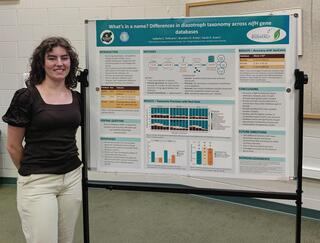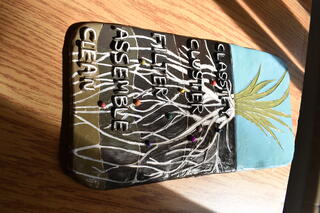Isabella Pellicano

Through text and imagery, I created an art piece that represents what I learned this summer: the complexity hiding below ground and the tools we can use to understand it.
The words “clean”, “assemble”, “filter”, “cluster”, and “classify” are the steps in a bioinformatics pipeline I helped develop this summer to analyze diazotroph sequencing data. We were specifically interested in free-living diazotrophs: these are microbes that fix atmospheric nitrogen and live in roots and soils, but do not directly associate with plants.
Using DNA extracted from switchgrass soils and roots, my mentor Brandon sequenced the nifH gene that encodes nitrogenase, the enzyme responsible for nitrogen fixation in diazotrophs. These sequences are the information we input into the pipeline. Cleaning removes low quality reads, assembling pairs forward and reverse sequences, filtering removes non-nifH homologs, clustering groups sequences into clusters, or OTUs (operational taxonomic units) at 97% similarity, and classification assigns taxonomic names to these OTUs.

I have placed “clean” deepest in the soil, as this first step deals with an immense quantity of raw, undeciphered data. This parallels the lack of understanding we have of the microbes and processes occurring in deep soils. The final step, “classify”, is closest to the surface, as this step assigns names to diazotroph OTUs. While taxonomic classification can be a useful tool to assess diversity, it remains flawed and incomplete. There are multiple databases available to classify diazotrophs, and my work this summer showed they don’t tend to agree on taxonomic classification, even at the phylum level. This is why the “classify” step is still below ground in my depiction: uncertainty persists even after the final step.
I created this piece using air dry clay and acrylic paint. Above ground, I included a single switchgrass plant framed by a blue sky. The aboveground simplicity was intentional to create a contrast with below-ground complexity. The colored spheres represent the diazotrophs themselves. I chose to use a wide variety of colors to represent the high diversity and rarity of these diazotroph species in soils and roots.